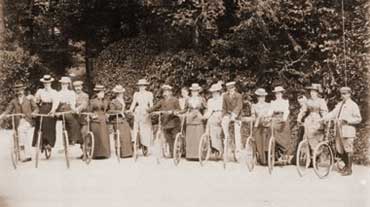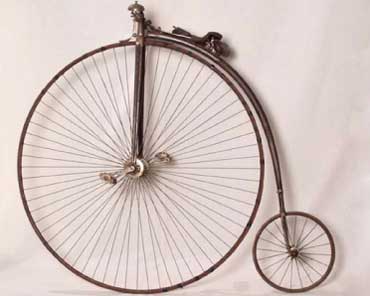Bikes in Athelstan Museum’s Collection
We are not a transport museum but we have a small and interesting collection of bicycles and tricycles.

Cycling started to become popular in the late 1800s. The first competitive race was in Paris in 1868 – won by an Englishman. Penny farthings were popular in the 1870s but by the turn of the century bikes were starting to look like today’s machines.
Cycling has been credited with changing the face of rural England. Courting was not restricted by the distance you could walk – with your bike you could roam much further afield. The increasing popularity of cycling clubs at the beginning of the nineteenth century opened up society for young people. The old folk disapproved and thought them most improper – imagine – young ladies riding astride!

Hand-driven and Foot-steered Tricycle
We believe this tricycle to be unique, although it may be copied from another. It dates from around 1850 and is thought to have been made by a man from Wootton Bassett, a town 10 miles to the east of Malmesbury. The saddle is not original, it has been replaced by a leather one at some point.
It seems a contrary way of doing things!
Years ago this tricycle was ridden in the Malmesbury Carnival celebrations.
Penny Farthing
So called, for the benefit of readers unfamiliar with pre-decimal coinage, from the relative sizes of the coins. The old penny was as large as a present 50p piece and the farthing much the size of a 5p. (The 5p is worth about 50 old farthings!)
Ever wondered how to get on? Follow the instructions:
- Stand at the rear of the bike and place your left leg on the mounting step while holding onto the handlebars. Look straight ahead.
- While looking straight ahead push off with your right foot and get the bike up to steady pace making sure you do not look down. Always look directly in front of you. A beginner may want to stay at this stage to feel out the bike and gather confidence before taking the next step.
- Now you have the bike moving along at a steady pace stand up on the mounting step and slide your body onto the saddle whilst at the same time throw your leg forward to catch the right pedal. Catching the pedal is very important for smoothness so you will want to time yourself to its point of revolution in order to catch it properly.
- Now that you have successfully mounted the bike, ride off at a steady pace always looking about four metres in front of you at all times. Lookout for anything that might be an obstacle in your path, and give yourself plenty of time to dodge it.
- Dismounting. When you want to dismount, slow the bike down then throw your left leg back and place it on the step. DO NOT look back to find the step as this task has to be completed while looking straight ahead. Practice makes perfect here. Remember to dismount only while the bike is going in a straight direction. If you do this while turning you could accidentally put your foot into the spokes. That would not be good.
- After placing your left leg on the step move your body out of the saddle while at the same time take your right leg off the pedal and bend your left leg and lower right leg to the ground. Some will use their foot to press against the rear wheel causing a braking action.
- Now your right foot should be placed on the ground, and once you are completely stopped you can take your left foot off the step. If these steps are followed you should be able to successfully ride your penny farthing with ease.





